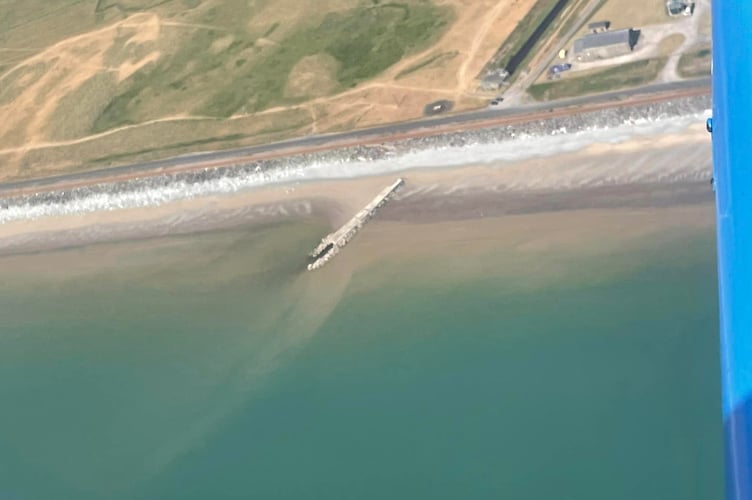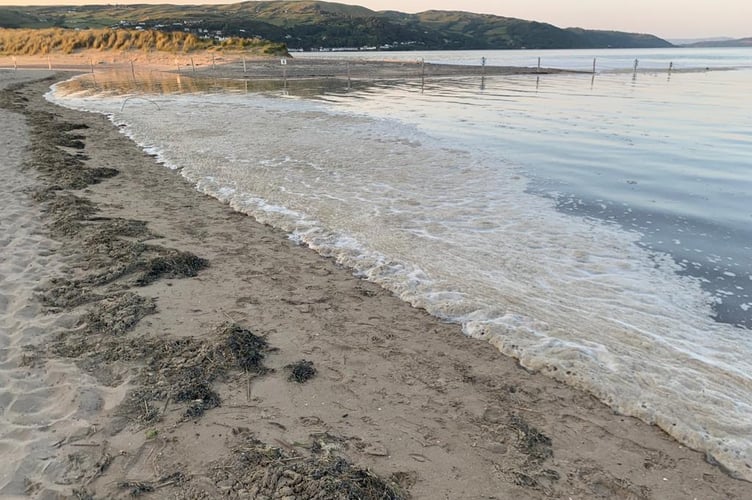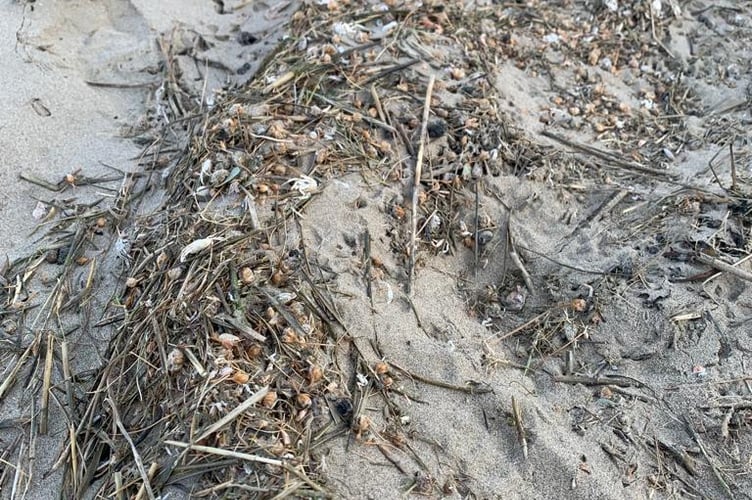Aerial images have sparked fears over sewage pollution in Tywyn days after swimmers were taken ill and photos emerged of dead fish along the coast.
Residents are also saying the photographs provided by Snowdonia Flight School, showing the sea next to the town's wastewater treatment works, call into question environmental regulator Natural Resources Wales’ (NRW) assertions about an incursion of thick, foul-smelling algal bloom - which resembles Guiness foam - being non-toxic and unrelated to effluent discharge.
But NRW said the pipe shown in the images is the town’s land drain – called Tywyn Main Drain – and is operated by the regulator and not the nation’s primary water supplier Dwr Cymru. A spokesperson added that further tests have been carried out and, so far, the results have not recorded the presence of sewage.
Dwr Cymru said it is ‘most definitely not the case’ that effluent is being released into the sea from its sewage treatment works in the town.
The images surfaced days after Tywyn caravan owner Clive Birch’s son went swimming with his friends who then became ill - suffering rashes and ‘three days of diarrhea and vomiting’.
An Aberdyfi chartered sea-angling skipper Charlie Bartlett told the Cambrian News that in 54 years of operating fishing boats he has never seen algal bloom as bad as it has been recently. He added that in the last few weeks, fish near the shoreline have all but disappeared.

A regular sea angler and owner of Bryn y Gwyn Holiday Park in Dolgellau, Ian Davey, said that when he went fishing in Fairbourne last Saturday the only thing he caught was toilet paper – and he saw fecal matter drifting by when he was wading.
Fears were sparked after the Cambrian News revealed at least four sewage tankers per day are being transported from a Dolgellau wastewater treatment works, which Dwr Cymru closed for ‘essential maintenance’, to a similar site in Tywyn just off Sandilands Road and Morfa Crescent.
But residents, businesses and ex-councillor Mike Stevens have claimed the number of lorries travelling through the town exceeds 10.
He added the situation has caused anger, a putrid stench and increased pollution.
An ex-environmental protection officer who contacted the Cambrian News but did not want to be identified said he is convinced the extra effluent from Dolgellau could be placing an excessive strain on the capacity of the Tywyn sewage treatment works, resulting in possible discharging.
Water companies euphemistically refer to these discharges as Combined Sewage Overflows (CSOs) and they are only permitted when extra pressure is placed on the nation’s outdated pipelines in extreme weather. But discharges should not be taking place during a hot snap and despite weeks without rain.
The ex-environmental officer told the Cambrian News the particularly heavy algal bloom could have worsened, and become smellier, because of these sewage discharges.
Mr Birch, also a regular angler off shores in Tywyn, provided photos to the Cambrian News of dead weaver fish – a bottom dwelling surface feeder – which he suspects were suffocated due to declining oxygen in the water.

The ex-officer said he was incensed by the failures that have led to what he fears could be multiple discharges.
“NRW is failing to do its job once again in dealing with pollution matters.
“The coastal tourism impact is very serious as no one can say what the E-Coli deposition is and for swimmers to come down with sickness after swimming in Tywyn beach is very rare.
“The question would need to be, did NRW know about it - and if they did, did they permit it?
“The algal bloom is a load of rubbish.
“For it to happen like this is unprecedented."
Mr Davey said he is worried about the future of his caravan site due to a reputation for water pollution damaging the region’s tourism industry.
“There’s nowhere where it is clean enough to fish anymore,” he said.
“It is diabolical. I went fishing at Fairbourne and the white froth on top of the water that I’ve never seen before was like Guinness foam.
“Greece and Spain get far warmer seas than we do and yet it’s crystal clear. It’s not just an algal bloom.
“Algae needs sunlight but also nutrients and it’s getting nutrients from the raw sewage – which is creating the algal bloom.
“Basically, it’s not safe to swim or fish in the sea now.

“And the problem is, the main income of this area is through tourism and once everyone realises it’s no longer safe to swim, fish, go on your paddle boards or your jet skis, can you imagine how many cancellations there are going to be?
“The Tywyn sewage treatment plant will only be able to deal with a certain amount of sewage – and it will be working at its maximum this time of year with all the tourists.
“If you’ve got a system that’s already at its maximum capacity and you take another 12 or 13 tanker loads to it every day, it can’t cope – and raw sewage is released.”
He also expressed fears that the apex predators like Dolphins, Otters, Osprey and Seals that survive on fish - which could be dying and contaminated if sewage discharges are occurring - could see their numbers threatened.
Mr Birch, who owns a caravan at Ynysmaengwyn holiday park, said: “I’ve got a boat, I fish, and I love cold water swimming.
“I’ve got a caravan which now I feel like selling, because I can’t do any of the things I like doing anymore.
“If you stand on top of the rocks as you go over onto the beach, you can see a big brown stain going down the coast.
“When you go down to the mouth of the Dysynni (river), you can see toilet paper and poo floating past you.
“There’s weaver fish and sand eels dying on the beach because there’s no oxygen in the water.

“I’ve been fishing down here for 40 years but I’ve never seen anything like this.”
Mr Bartlett said he noticed about three weeks ago when the algae bloom turned up that he was not catching as many fish – and he had to start driving his boat out at least four miles to get away from it.
“I’ve never seen an algae bloom like it in my life and I’ve worked out at sea for 54 years,” he said.
“The fishing and the reef are dead. There’s usually loads of fish there – but we’re getting nothing.
“I go into the deep water – about three or four miles out – and we get fish. But nothing on the inside of the reef.
“I think the nitrates and phosphates in the sewage are creating algae bloom. Big time.
“It’s very concerning to me because I owe my livelihood to the sea – and it’s particularly concerning due to the environmental damage it’s doing to that reef – which is a Special Area of Conservation (SAC).
“It’s also going to affect the biggest population of (critically endangered) angel sharks – a very special species – in the whole of Europe!”
A spokesperson for Natural Resources Wales said: “A number of water samples have confirmed the presence of Phaeocystis algal blooms along the coast at locations between Aberdyfi and Harlech, including Tywyn. This is part of a more extensive bloom in Cardigan Bay that has been recorded along the Welsh coastline.
“These non-toxic blooms form a brown, frothy scum on the water and when breaking down can smell like sewage. Algal breakdown can lead to low oxygen and fish distress in warm shallow waters.
“So far, our water samples have recorded the algal bloom and have not shown the presence of sewage, but we remain vigilant and will continue with our monitoring.
“The full results of further tests carried out on Monday will be available early next week, however initial findings confirm the algal bloom and do not indicate sewage.
“Dwr Cymru Welsh Water has informed us their site in Tywyn is operating within its limits and we will continue to monitor the situation and carry out further bathing water sampling and source checking at Tywyn as part of our regulatory role.
“Members of the public are encouraged to contact our 24-hour incident line on 03000 65 3000 if they see an environment or pollution incident.”
Dwr Cymru’s full response to questions from the Cambrian News:
“We can confirm our Tywyn water treatment works is operating normally and is able to manage the waste it is temporarily treating from Dolgellau works.
“We are aware of claims locally that waste is now being put straight into the sea but to be clear, we can confirm this is most definitely not the case.
“We are also arranging to meet with the community council to show them exactly how all of the waste is being treated at the works.
What exactly is wrong with the Dolgellau sewage treatment plant? What is the maintenance that needs doing? How much is this maintenance going to cost?
“There is a problem on one of the treatment tanks in Dolgellau Wastewater treatment works which means we have reduced capacity to treat on site. Our contractors are currently working on repairing the tank and this work should be finished by October but we are doing everything we can to finish sooner than that if possible. In the meantime we are also carrying out other work on site which should reduce the need to tanker flows from the site over the next few months.”
What is your response to the images of the sea near Tywyn sewage treatment works I’ve attached? Have there been any raw sewage discharges into the sea off Tywyn? Can we include when the last storm discharge was?
“Our wastewater treatment works at Tywyn is operating normally and we can confirm there are no operational issues on site and no discharges made to sea. The site is checked by an operator 6 days a week and monitored 24 hours by our monitoring system.”
Is the Tywyn sewage plant – taking on the extra load from Dolgellau – fit to process so much sewage or is it at capacity? Is capacity being tested? Hence the discharges into the ocean
“It is standard practice to treat wastewater from other sites at larger nearby treatment works while maintenance or upgrades are being carried out. Using a larger site such as Tywyn, which can treat additional flows while remaining compliant, will ensure we protect the environment while the works takes place. Should there be a capacity issue at Tywyn then we would temporarily stop tankering from our Dolgellau site to Tywyn. We would also add that our works at Tywyn has an ultra-violet treatment process which is a disinfectant process the treated water goes through before being safely returned to the environment.”
Did NRW sign off on plans to transport the sewage from Dolgellau to Tywyn knowing it would test the capacity of the plant and could result in discharge into the sea?
“Our Tywyn wastewater treatment works remains in compliance and Natural Resources Wales are fully aware of the work being carried out in Dolgellau site and our tankering to Tywyn works.”




